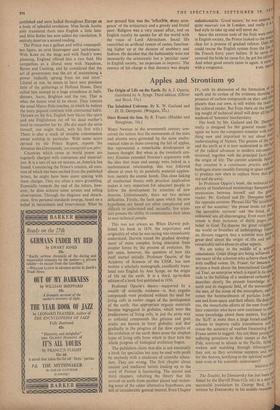Apples and Strontium 90
Once Round the Sun. By R. Fraser. (Hodder and Stoughton, 16s.) WHEN Newton in- the seventeenth century con- ceived the notion that the movements of the stars and planets were governed by the same mathe- matical rules as those covering the fall of apples, this represented a remarkable development in human thought. But when in the twentieth cen- tury Einstein extended Newton's arguments with the idea that mass and energy were linked in a mathematical relationship, this was followed almost at once by its painfully material applica- tion, namely the atomic bomb. This close linking pf intellectual theory with practical application makes it very important for educated people to follow the development by scientists of new theories. Unfortunately, there are two serious difficulties. Firstly, the facts upon which the new hypotheses are based are often complicated and difficult to understand and, secondly, few scien- tists possess the ability to communicate their ideas to non-technical people.
This was not always so. When Darwin pub- lished his book in 1859, the importance and originality of what he was saying was immediately understood. Darwin traced the gradual develop- ment of more complex living creatures from simpler forms by the process of evolution. He left open, however, the question of how life itself started initially. Professor Oparin, of the Academy of Sciences of the USSR, has now written a scholarly monograph, excellently trans- lated into English by Ann Synge, on the origin of life on the earth. It is a third, up-to-date edition of a book first published in 1936.
Professor Oparin's theory—supported by a wealth of scientific evidence—is that organic compounds were produced without the need for living cells in earlier stages of the development of the earth; that appropriate organic materials become segregated in globules, which were the predecessors of living cells, in just the same way as colloidal compounds like gelatine and gum arabic are known to form globules; and that gradually in the progress of the slow epochs of the evolution of the earth there arose the simplest types of living cells from which in their turn the whole progress of biological evolution began.
The publishers claim that .this is not essentially a book for specialists but may be read with profit by anybody with a modicum of scientific educa- tion. They are wrong. The first chapter about ancient and mediaeval beliefs leading up to the work of Pasteur is fascinating. The second and third chapters, rebutting the theory that life arrived on earth from another planet and review- ing some of the odder alternative hypotheses, are still of considerable general interest. Even Chapter
IV, with its discussion of the formation of th earth and its review of the evidence showing presence of carbon compounds on stars and nth planets than our own, is still within the reach ci the cultural reader. But from there on the mount ing weight of technical detail will deter all but' students of 'honours' biochemistry. The book by Mr. Gatland and Dr. DeMEs really is designed for the general reader. rice, again we have the competent scientist with 01111 thing new and important to say about Inallo understanding of Nature. The genesis of the slabi and the earth as it is now understood in the ligis of the radical advances in modern astronoMY0 reviewed, together with the principal facts all the origin of life. The current scientific belief, that creation is a continuous process and t"4 hydrogen atoms steadily forming in space coales, ; to produce new stars to replace those that grin old and die away. In Professor Oparin's book, the technical cod' plexity of biochemical terminology hampers 1 munication between himself and the gen, reader. Mr. Gatland and Dr. Dempster taw., the opposite extreme. Phrases like 'the penetrat1. eye of the scientist,' the proud brain (of inati 'the incredible universe' and 'the brink of tN unknown' are all discouraging. Even more unfl); tunate is their inclusion of thirty pages abc)4i belief in God. To dismiss the great religions4 the world as branches of anthropology foune1 on illusion suggests that a scientist may ktOsv great deal about the origin of, life and still remarkably naive about its other aspects. ig We are today in the middle of a scierIdno renaissance. Great things are being achieved. PA too many of the scientists who achieve them sPo; with muffled voices. Dr. Fraser, for instance, 11; written a book about the International GeoPil) cal Year, an enterprise which is equal in its rnag; tude to the building of a mediaeval cathedral' describes clearly the present knowledge 01 '01 earth and its magnetic field, of the .i ,i5 the seas, of the zones of the atmosphere, and udgt cusses the bombardments of particles from, sun and from space and their effects. He deserlir, too, the remarkable efforts of the men from 6111'; four countries who have now combined to obt:i, more knowledge about these matters. Yet stir,ej'' the 'IGY' is more than a large bread-and-butt .0, scheme to improve radio transmission and crease the accuracy of weather forecasting as weo Fraser seems to suggest. Are not these young nltb suffering privations in their camps at the Solid Pole, scattered in islands in the Pacific, firing it rockets and watching through telescopes ta they not, as they scrutinise sunspots and watt for the Aurora, testifying to the spiritual nature man even in his scientific endeavours? MAGNUS 01 The Double, by Dostoevsky has just been Pti; lished by the Harvill Press (12s. 6d.) in a new successful translation by George Bird, It " written by Dostoevsky in his middle twenties'






























 Previous page
Previous page